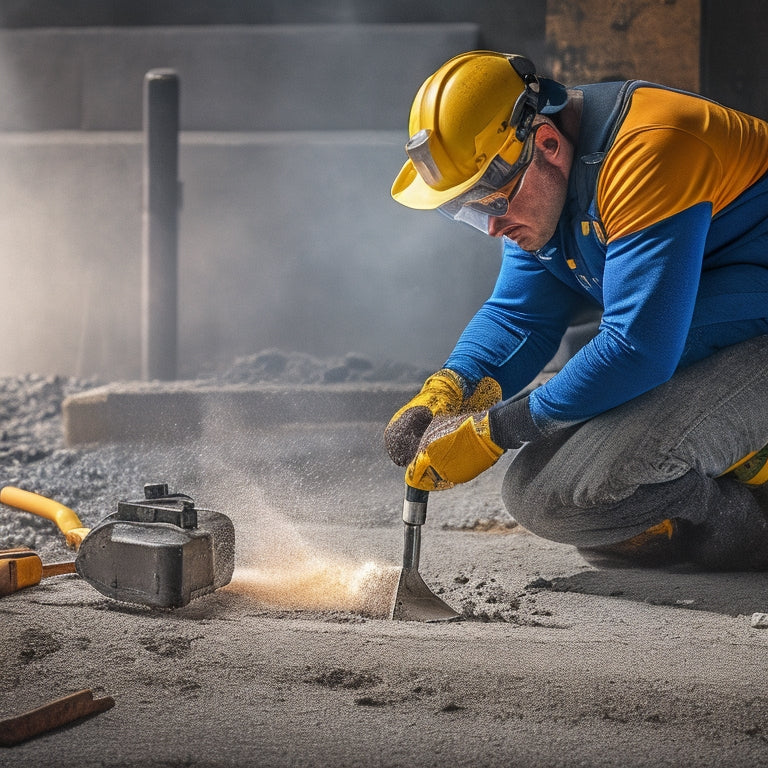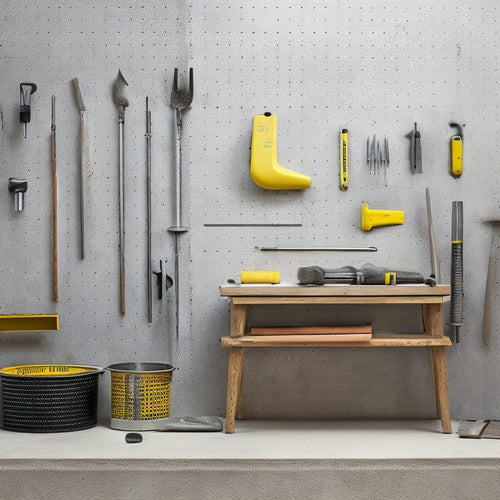
Best Tools for Splitting Concrete Blocks Efficiently
Share
When splitting concrete blocks efficiently, you'll want to choose from the best tools for the job. Consider electric splitting saws for precise cuts in dense blocks, or hydraulic concrete block cutters for heavy-duty applications. Diamond blade circular saws offer versatility for small to medium-sized blocks, while pneumatic chiseling hammers provide adjustable air pressure and stroke rate for efficient splitting. Alternatively, gas-powered demolition saws offer portability and power, or concrete block splitting machines for high-volume processing. By selecting the right tool, you'll optimize your workflow and guarantee accurate results. To get the most out of your chosen tool, it's crucial to learn more about its specific features and operation.
Key Takeaways
• Electric splitting saws provide precise cuts and are ideal for dense concrete blocks, but require regular maintenance and safety precautions.
• Hydraulic concrete block cutters offer clean, straight cuts and are suitable for heavy-duty applications and larger blocks.
• Diamond blade circular saws are versatile for small to medium-sized blocks and can be used for both wet and dry cutting with high-quality blades.
• Pneumatic chiseling hammers are efficient for concrete block splitting with adjustable air pressure and stroke rate, and proper hammer bit selection.
• Concrete block splitting machines increase precision and control, saving time and energy, and are essential for high-volume concrete block processing.
Electric Splitting Saws
When dealing with dense concrete blocks, electric splitting saws emerge as a top choice for their ability to deliver precise cuts and minimize manual labor.
As you opt for this tool, it's important to prioritize safety precautions to avoid accidents. Always wear protective gear, including gloves, safety glasses, and a dust mask, to shield yourself from flying debris and dust. Verify the saw is placed on a stable surface, and the work area is clear of obstacles.
To maximize the lifespan of your electric splitting saw, follow these maintenance tips. Regularly inspect the saw blade for signs of wear and tear, and replace it when necessary. Clean the saw's air vents and filters to prevent overheating. Lubricate the blade shaft and other moving parts to reduce friction and wear.
Additionally, store the saw in a dry, protected area to prevent rust and corrosion. By following these guidelines, you'll be able to efficiently split concrete blocks while preserving your safety and the longevity of your equipment.
Hydraulic Concrete Block Cutters
You'll find hydraulic concrete block cutters to be a reliable option for splitting dense concrete blocks, especially when working with larger or heavier blocks that require extra force. These machines utilize hydraulic pressure to generate the necessary power to split the concrete, making them ideal for heavy-duty applications.
When it comes to cutting precision, hydraulic concrete block cutters excel. They're designed to provide a clean, straight cut, which is essential when working with large or irregularly shaped blocks.
Hydraulic concrete block cutters are also relatively low-maintenance compared to other splitting tools. They're built to withstand the rigors of heavy use, and their hydraulic systems are designed to provide consistent, reliable performance. Additionally, they're often quieter and produce less vibration than other splitting tools, making them a more comfortable option for operators.
When choosing a hydraulic concrete block cutter, look for models with high hydraulic pressure ratings and adjustable cutting depths. This will guarantee you can tackle even the toughest concrete blocks with ease.
With their impressive cutting precision and reliability, hydraulic concrete block cutters are an excellent addition to any concrete splitting arsenal.
Diamond Blade Circular Saws
For smaller to medium-sized concrete blocks, diamond blade circular saws offer a versatile and efficient alternative to hydraulic concrete block cutters, providing a high degree of portability and flexibility on the job site. These saws are ideal for making precise cuts and can be used for both wet and dry cutting applications.
When choosing a diamond blade circular saw, consider the following key factors:
| Factor | Description | Importance |
|---|---|---|
| Blade Quality | High-quality blades with synthetic diamonds or CBN (cubic boron nitride) cutting edges provide longer lifespan and better performance. | High |
| Power Output | Saws with higher power output (measured in amps or watts) can cut through concrete more efficiently. | Medium |
| Dust Collection | Effective dust collection systems reduce airborne particles and improve operator safety. | Medium |
| Weight and Ergonomics | Lighter saws with ergonomic handles reduce operator fatigue and improve maneuverability. | Low |
To get the most out of your diamond blade circular saw, focus on proper blade maintenance, such as regular cleaning and inspection, and develop effective cutting techniques, like using a steady, consistent motion and applying gentle to moderate pressure. By doing so, you'll be able to make precise, efficient cuts and maximize your productivity on the job site.
Pneumatic Chiseling Hammers
When you're working with pneumatic chiseling hammers, you'll want to take into account three key factors to guarantee efficient and effective concrete block splitting.
You'll need to select the right hammer bits for the job,
control the air pressure to avoid damaging the tool or the block,
and adjust the stroke rate to optimize your progress.
Hammer Bit Selection
Selecting the right hammer bit is essential to efficiently splitting concrete blocks with a pneumatic chiseling hammer, as it directly impacts the tool's performance and your productivity.
You'll want to choose a bit that's designed for your specific task and can withstand the demands of concrete demolition.
When it comes to hammer bit materials, you'll typically find bits made from high-carbon steel, tungsten carbide, or chromium-molybdenum steel. Each material has its strengths, but tungsten carbide bits are often preferred for their exceptional durability and resistance to wear.
Hammer bit sizes are also vital, as they determine the width of the chiseling pattern. Common sizes range from 1/2 inch to 2 inches in diameter, with larger bits providing more aggressive chiseling action. However, larger bits may also increase the risk of bit breakage.
You'll need to strike a balance between bit size and the density of the concrete blocks you're working with.
Air Pressure Control
You'll need to adjust the air pressure control on your pneumatic chiseling hammer to enhance its performance for splitting concrete blocks, as excessive pressure can lead to premature tool wear and decreased efficiency. Proper air pressure control is vital to achieve efficient concrete block splitting.
To achieve peak performance, verify your air compressor is fine-tuned for the task at hand. Check the compressor's capacity to deliver the required air volume and pressure. Calibrate the pressure gauge to guarantee accurate readings. A well-calibrated gauge will help you maintain the recommended operating pressure, usually between 90-110 PSI.
When adjusting the air pressure control, consider the type of concrete blocks you're working with and the bit's size and type. Thicker blocks may require higher pressure, while smaller bits may require lower pressure to prevent damage.
Keep in mind that excessive pressure can lead to overheating, which can damage the tool and reduce its lifespan. By fine-tuning the air pressure control, you'll be able to split concrete blocks efficiently and effectively, while also extending the life of your pneumatic chiseling hammer.
Stroke Rate Adjustment
Stroke Rate Adjustment
Adjusting the stroke rate of your pneumatic chiseling hammer is essential for optimizing its performance when splitting concrete blocks, as it directly impacts the tool's efficiency and productivity. You'll want to strike the right balance between speed and control to achieve the best results. A higher stroke rate can lead to faster completion times, but may also increase the risk of tool wear and tear, as well as reduced precision.
To optimize your stroke rate, consider the following factors:
| Stroke Rate | Recommended Use |
|---|---|
| Low (300-500 BPM) | Delicate or precision work, such as removing old mortar or breaking up small blocks |
| Medium (500-800 BPM) | General-purpose splitting of concrete blocks, suitable for most applications |
| High (800-1200 BPM) | Heavy-duty demolition or breaking up large blocks, where speed is a priority |
| Variable | Adjustable stroke rate control, ideal for adapting to different block types and sizes |
Concrete Block Splitting Machines
Concrete block splitting machines are designed to efficiently divide concrete blocks into uniform sizes and shapes, offering a high level of precision and control.
When you're working with large quantities of concrete blocks, these machines can be a game-changer, saving you time and energy. Unlike manual block splitting, which can be labor-intensive and prone to errors, concrete block splitting machines provide consistent results with minimal effort.
However, it's crucial to take safety precautions when operating these machines. Make sure you wear protective gear, including gloves and safety glasses, and follow the manufacturer's instructions to avoid accidents. Additionally, verify the machine is properly maintained and calibrated to prevent malfunctions.
With a concrete block splitting machine, you can achieve precise cuts and uniform sizes, making it ideal for construction projects that require exact specifications. By investing in one of these machines, you'll be able to work more efficiently and effectively, ultimately saving you time and money.
Gas-Powered Demolition Saws
Gas-powered demolition saws offer a powerful and portable solution for splitting concrete blocks, providing a high torque output that enables you to cut through dense materials with ease.
When operating these saws, it's vital to take safety precautions seriously. Always wear protective gear, including gloves, safety glasses, and a dust mask, to minimize the risk of injury. Confirm you're working in a well-ventilated area, away from flammable materials, and keep a fire extinguisher nearby.
Regular maintenance is important to prolong the life of your gas-powered demolition saw. You should check and clean the air filter daily, and replace it every week or as recommended by the manufacturer. Additionally, inspect the saw blade regularly for signs of wear and damage, and replace it as needed.
Properly store the saw when not in use, and follow the manufacturer's guidelines for winterization and storage. By following these maintenance tips, you'll be able to achieve the best performance and extend the lifespan of your gas-powered demolition saw.
Frequently Asked Questions
What Safety Gear Is Required When Splitting Concrete Blocks?
When splitting concrete blocks, you must prioritize your safety above all else.
You'll need to wear essential protective equipment, including safety glasses, gloves, and a dust mask to prevent eye and respiratory damage.
Additionally, wear long sleeves, pants, and steel-toed boots to protect your skin and feet from debris.
Don't forget a hard hat and ear protection to safeguard against falling objects and loud noises.
Can I Use These Tools for Splitting Other Materials Like Asphalt?
When you're considering splitting materials beyond concrete blocks, you're likely wondering about asphalt cutting.
The good news is that many of the tools you're using can demonstrate material versatility. You can, in fact, use them to cut through asphalt, but be prepared to adjust your technique and potentially switch to specialized blades designed specifically for asphalt cutting.
This will guarantee you're getting the most efficient and effective results.
How Do I Maintain and Clean My Concrete Splitting Tools?
As you wrap up a long day of splitting concrete, your tools, once mighty, now lie exhausted, caked in dust and debris.
Don't let them rust away - give them the TLC they deserve! Proper tool storage is key: keep them dry, clean, and organized.
Follow these maintenance tips: regularly inspect for damage, lubricate moving parts, and sharpen cutting edges.
Are Electric Splitting Saws Suitable for Outdoor Use in Wet Conditions?
When considering electric splitting saws for outdoor use in wet conditions, you'll want to scrutinize the saw's specifications.
Check the IP rating, which indicates resistance to solid particles and water. A higher rating, such as IP67, guarantees protection against heavy rain and immersion.
Additionally, review the manufacturer's outdoor usage guidelines, as some saws may require special precautions or covers to operate safely in wet environments.
What Is the Average Cost of a Hydraulic Concrete Block Cutter?
As you venture into the world of concrete block cutting, you'll want to know the average cost of a hydraulic concrete block cutter.
The prices of these powerful tools vary, but you can expect to pay between $1,500 and $5,000, depending on the brand, quality, and features.
When comparing costs, consider the trade-off between manual and hydraulic cutters, as well as the benefits of electric and pneumatic options.
A thorough cost comparison will help you make an informed decision for your project's specific needs.
Conclusion
You've made it through the gauntlet of concrete block splitting tools, and you're still standing. Congratulations!
You now know the best ways to tear apart those stubborn blocks with ease. It's almost as if you're going to put them out of their misery... or yours, depending on how you look at it.
Seriously though, with these tools, you'll be the one in control, not the concrete.
Related Posts
-

10 Must-Have Tools for Concrete Repair Organization
You'll need a solid organization system to keep your concrete repair tools and materials within easy reach, protected...
-

Essential Power Tools for DIY Concrete Sculpting
As you begin DIY concrete sculpting, you'll need a strategic selection of power tools to achieve professional-grade r...
-

Top Tools for Beginners in Concrete Masonry Coating
You're about to begin a concrete masonry coating project, and having the right tools is essential. Start with essenti...


